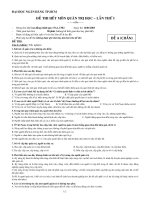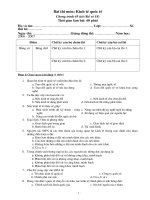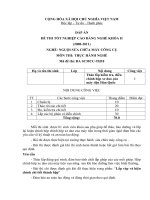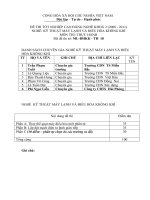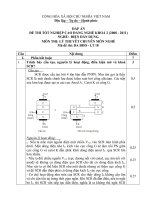18 noyori asymmetric hydrogenation reaction
Bạn đang xem bản rút gọn của tài liệu. Xem và tải ngay bản đầy đủ của tài liệu tại đây (1.07 MB, 11 trang )
Myers
Chem 115
The Noyori Asymmetric Hydrogenation Reaction
Reviews:
Mechanism:
Noyori, R. Angew. Chem. Int. Ed. 2013, 52, 79–92.
• Catalytic cycle:
1/n {[(R)-BINAP]RuCl2}n
2 CH3OH
Kitamura, M.; Nakatsuka, H. Chem. Commun. 2011, 47, 842–846.
Tang, W.; Zhang, X. Chem. Rev. 2003, 103, 3029–3069.
Noyori, R.; Ohkuma, T. Angew. Chem. Int. Ed. 2001, 40, 40–73.
[(R)-BINAP]RuCl2(CH3OH)2
H2
Original Report by the Noyori Group:
OCH3
O
HCl
CH3OH
O
[(R)-BINAP]RuHCl(CH3OH)2
H2
CH3
2 CH3OH
H2 (100 atm)
O
CH3
O
OH O
RuCl2[(R)-BINAP] (0.05 mol %)
OCH3
OCH3
OCH3
CH3
CH3OH, 36 h, 100 °C
O
[(R)-BINAP]RuCl(CH3O)(CH3OH)2
96%, >99% ee
[(R)-BINAP]HClRu
O
OCH3
CH3
O
Noyori, R., Okhuma, T.; Kitamura, M.; Takaya, H.; Sayo, N.; Kumobayashi, H.; Akuragawa, S.
J. Am. Chem. Soc. 1987, 109, 5856–5858.
OCH3
HO
O
CH3
2 CH3OH
CH3OH
[(R)-BINAP](CH3OH)ClRu
O
CH3
• Both enantiomers of BINAP are commercially available. Alternatively, both enantiomers can be
Noyori, R. Asymmetric Catalysis in Organic Synthesis; John Wiley & Sons: New York, 1993,
pp. 56–82.
prepared from the relatively inexpensive (±)-1,1'-bi-2-naphthol.
• The reduction of methyl 2,2-dimethyl-3-oxobutanoate proceeds in high yield and with high
enantioselectivity, providing evidence that the reduction proceeds through the keto form of the !-keto
ester. However, pathways that involve hydrogenation of the enol form of other !-keto esters cannot be
PPh2
PPh2
OH
OH
PPh2
PPh2
+
ruled out.
H2 (100 atm)
(±)-1,1'-Bi-2-naphthol
O
(R)-(+)-BINAP
20%
O
RuCl2[(R)-BINAP]–Ru
OCH3
CH3 CH3
CH3OH, 23 °C
(S)-(–)-BINAP
20%
CH3
OH
CH3
O
OCH3
CH3 CH3
99%, 96% ee
Takaya, H.; Akutagawa, S.; Noyori, R. Org. Synth. 1989, 67, 20–32.
Noyori, R.; Takaya, H. Acc. Chem. Res. 1990, 23, 345–350.
Andrew Haidle
1
Myers
The Noyori Asymmetric Hydrogenation Reaction
• The use of a deuterated substrate provides further evidence that the reduction proceeds
Chem 115
• Of the two possible diastereomeric transition states for complexes with (R)-BINAP shown
through the keto tautomer. Enolization is rapid, so the deuterium is lost quickly. However,
below, the one leading to the (R) !-hydroxy ester allows the approach of the ketone at an
when the reaction was stopped at 1.3% conversion, the hydroxy ester product retained
unhindered quadrant (as represented by the light lower left quadrant of the circle).
80% of the deuterium at C-2, and no deuterium was incorporated at C-3.
O
O
O
O
OCH3
D NHAc
H2 (100 atm)
OH O
RuBr2[(R)-BINAP]
O
CH2Cl2
O
OCH3
D NHAc
P
Cl
P
O
O
CH3
H
CH3
OH O
(R)-BINAP
Ru
OCH3
OCH3
(R) !-hydroxy ester
Noyori, R.; Ikeda, T.; Okhuma, T.; Widhalm, M.; Kitamura, M.; Takaya, H.; Akutagawa, S.;
Sayo, N.; Saito, T.; Taketomi, T.; Kumobayashi, H. J. Am. Chem. Soc. 1989, 111, 9134–9135.
• A crystal structure of Ru(OCOCH3)2[(S)-BINAP] revealed that the rigid BINAP backbone forces
P
the phenyl rings attached to phosphorous to adopt the conformation depicted here (the napthyl
Cl
P
Ru
O
rings are omitted for clarity).
CH3
H
CH3O
OH O
(R)-BINAP
O
OCH3
(S) !-hydroxy ester
CH3
axial
equatorial
P Ru P
Ru(OCOCH3)2[(S)-BINAP]
Noyori, R.; Tokunaga, M.; Kitamura, M. Bull. Chem. Soc. Jpn. 1995, 68, 36–56.
Reaction Conditions:
• Noyori has published conditions to prepare the active Ru-BINAP catalyst in one step from
commercially available [RuCl2(benzene)]2, and it can be used without a purification step.
Also, the reaction can be run at 4 atm/100 °C or 100 atm/23 °C.
• The two protruding equatorial P-phenyl groups allow a coordinating ligand access to only two
1/
2
[RuCl2(benzene)]2 + (R)-BINAP
DMF, 100 ºC
(R)-BINAP-Ru(II)
quadrants on the accessible face of Ru (the other face is blocked by BINAP's napthyl rings).
This situation is represented by a circle with two black quadrants where no coordination can occur.
Kitamura, M.; Tokunaga, M.; Okhuma, T; Noyori, R. Org. Synth. 1993, 71, 1–13.
Ohta, T.; Takaya, H.; Noyori, R. Inorg. Chem. 1988, 27, 566–569.
Andrew Haidle, Fan Liu
2
Myers
The Noyori Asymmetric Hydrogenation Reaction
• The procedure involving in situ catalyst generation was found to be much more reliable. Also,
Chem 115
• These conditions have been improved on even further, with milder reaction conditions and
lower catalyst loadings.
reactions with this catalyst were more enantioselective and required less catalyst. The
following reaction was done on a 10-kg scale. Note the benzyl group is not removed.
H2 (50 psi), HCl (0.1 mol%)
O
H2 (4 atm), (R)-BINAP
O
O
BnO
OH O
[C6H6RuCl]2 (0.05 mol %)
OEt
BnO
CH3
OH O
Ru–(R)-BINAP (0.05 mol %)
Ot-Bu
OEt
EtOH, 100 °C, 6 h
(10.0 kg)
O
CH3OH, 40 °C, 8 h
CH3
Ot-Bu
97%, >97% ee
(9.7 kg)
96%, 97–98% ee
• The authors present kinetic data to show the dramatic increase in reaction rate that occurs
in the presence of a catalytic amount of strong acid, and they suggest that failed reactions
Beck, G.; Jendralla, H.; Kesseler, K. Synthesis 1995, 1014–1018.
may be a result of low levels of basic impurities. Note that the acid-sensitive t-Bu ester is
not cleaved under these conditions.
• A simplified, milder set of conditions that also features a catalyst available in one step from
commercially available BINAP and RuCl2•cyclooctadiene has been published. The reaction
proceeds at a sufficiently low H2 pressure (50 psi) to avoid reduction of trisubstituted olefins,
King, S. A.; Thompson, A. S.; King, A. O.; Verhoeven, T. R. J. Org. Chem. 1992, 57,
6689–6691.
but not terminal olefins.
• Reduction of !-keto esters has been achieved at 1 atm of hydrogen using a catalyst
H2 (50 psi)
O
CH3
O
OCH3
CH3OH, 80 °C, 6 h
prepared in situ from BINAP, (COD)Ru(2-methylallyl)2, and HBr, all of which are
OH O
Ru–(S)-BINAP (0.2 mol %)
commercially available. No special reaction apparatus is necessary for this procedure;
CH3
OCH3
however, the catalyst loading is unusually high.
90%, 98% ee
H
H2 (1 atm)
O
N
CH3
CH3
O
OH O
Ru–(S)-BINAP (2 mol %)
OCH3
CH3
acetone, 50 °C, 3.5 h
OCH3
CH3
100%, 99% ee
(–)-Indolizidine 223AB
Genet, J. P.; Ratovelomanana-Vidal, V.; Caño de Andrade, M. C.; Pfister, X.; Guerreiro, P.;
Taber, D. F.; Silverberg, L. J. Tetrahedron Lett. 1991, 32, 4227–4230.
Taber, D. F.; Deker, P. B.; Silverberg, L. J. J. Org. Chem. 1992, 57, 5990–5994.
Lenoir, J. Y. Tetrahedron Lett. 1995, 36, 4801–4804.
Andrew Haidle, Fan Liu
3
Myers
The Noyori Asymmetric Hydrogenation Reaction
Chem 115
Substrates:
• Chiral substrates:
• !-Keto esters are typically the best substrates. However, nearly any substrate that has an
OH O
ether or amine separated from a ketone by 1–3 carbons will be reduced to the corresponding
Ph
OEt
NHBoc
secondary alcohol with high yields and high enantioselectivities.
H2 (100 atm)
OH
O
X
R
OH
(R)-BINAP–Ru
X
H2
OH
(S)-BINAP–Ru
X
R
R
RuBr2[BINAP] (0.18 mol %)
OEt
EtOH, 23 °C, 145 h
NHBoc
OH O
Ph
X
R
OEt
NHBoc
OH
X
R
syn
OH
O
X
O
Ph
X
R
O
H2
R
OH
X
R
O
anti
X
R
X = OR, NR2
• The authors propose that the heteroatom is necessary because the substrate must function as a
bidentate ligand for Ru.
configuration of BINAP
% yield
syn : anti
R
98
>99:1
S
96
9:91
Kitamura, M.; Ohkuma, T.; Inoue, S.; Sayo, N.; Kumobayashi, H.; Akutagawa, S.; Ohta, T.;
Takaya, H.; Noyori, R. J. Am. Chem. Soc. 1988, 110, 629–631.
• The (R)-BINAP case represents a stereochemically
matched case, while the (S)-BINAP catalyzed case
has to override the inherent syn selectivity of the
• Example:
substrate:
RuCl2[(S)-BINAP] (0.1 mol%)
OEt
CH3
O
94%, 99.5% ee
Okhuma, T.; Kitamura, M.; Noyori, R. Tetrahedron Lett. 1990, 31, 5509–5512.
OCH3
H
H
Bn
NHBoc
H
O
EtOH, 30 °C, 100 h
2. AcOH, toluene, reflux
O
O
proposed T.S.
1. H2 (100 atm)
O
X
P
P Ru
O
• Analysis of the results show that for this substrate, catalyst control is >32:1, while the
H3C
substrate control is only 3:1.
Nishi, T.; Kitamura, M.; Okhuma, T.; Noyori, R. Tetrahedron Lett. 1988, 29, 6327–6330.
Andrew Haidle, Fan Liu
4
Myers
Chem 115
The Noyori Asymmetric Hydrogenation Reaction
Dynamic Kinetic Resolution:
• The stereochemistry of the secondary alcohol is determined by the choice of catalyst, but
• Kinetic resolution of enantiomers occurs when the chiral catalyst reacts with one enantiomer much
the stereochemistry at the !-position is substrate dependent.
more rapidly than the other.
O
O
HO
OH
H2 (100 atm)
HO
RuCl2[(R)-BINAP]
CH3
O
HO
CH3
O
CH3
OCH3
RuBr2[(R)-BINAP]
CH3
CH3
OH O
H2 (100 atm)
CH3
OH O
OCH3
CH3
OCH3
CH3
CH3
EtOH
1:1
kS/kR = 64
49.5%, 92% ee
50.5%, 92% ee
O
• An inherent drawback to kinetic resolution is the fact that the maximum yield is 50% of
O
H2 (100 atm)
OCH3
HO
H
HO
O
H
O
OCH3
[RuCl(PhH)((R)-BINAP)]Cl
OCH3
(0.09 mol %)
enantiopure material.
99 : 1
Noyori, R. Asymmetric Catalysis in Organic Synthesis; John Wiley & Sons: New York, 1993,
pp. 56–82.
• Epimerizing systems can give rise to a dynamic kinetic resolution, where the maximum theoretical
yield is 100%.
• The preference for one diastereomer over the other can be rationalized by examining the likely
transition states for carbonyl reduction. If the reduction of the !-amino compound, below right, is
carried out in methanol instead of dichloromethane, the diastereoselectivity drops from
99 : 1 to 82 : 18.
O
OCH3
NHAc
CH3
kinv
kinv
O
CH3
H2 (100 atm)
O
O
OCH3
NHAc
RuBr2[(R)-BINAP] (0.4 mol %)
OH O
CH3
CH2Cl2, 15 °C, 50 h
kR,R
Ru
OH O
CH3
P,P = (R)-BINAP
O
O
H
H2 (100 atm)
CH2Cl2, 15 °C, 50 h
P
P
99%, 98% ee
kS,R
RuBr2[(R)-BINAP] (0.4 mol %)
X
OCH3
NHAc
OCH3
X
P
Ru
P
H3C
O
O H
O
N
H
H
CH3
H
CH3
O
P,P = (R)-BINAP
OCH3
NHAc
1%, >90% ee
• To achieve yields approaching 100%, isomerization must be rapid relative to reduction
(kinv > kS,R and kR,R).
Noyori, R.; Ikeda, T.; Okhuma, T.; Widhalm, M.; Kitamura, M.; Takaya, H.; Akutagawa, S.;
Sayo, N.; Saito, T.; Taketomi, T.; Kumobayashi, H. J. Am. Chem. Soc. 1989, 111, 9134–9135.
Noyori, R.; Ikeda, T.; Okhuma, T.; Widhalm, M.; Kitamura, M.; Takaya, H.; Akutagawa, S.;
Sayo, N.; Saito, T.; Taketomi, T.; Kumobayashi, H. J. Am. Chem. Soc. 1989, 111, 9134–9135.
• A detailed mathematical model of the dynamic kinetic resolution process has been
published.
Kitamura, M.; Tokunaga, M.; Noyori, R. J. Am. Chem. Soc. 1993, 115, 144–152.
Andrew Haidle
5
Myers
Chem 115
The Noyori Asymmetric Hydrogenation Reaction
Other Ligands:
• Noyori has discovered a Ru–based catalyst, trans-RuCl2[(R)-xylbinap][(R)-diapen], that efficiently
• Burk's 1,2-bis(trans-2,5-diisopropylphospholano)ethane (i-Pr-BPE) is a useful ligand for the
reduces "-, !-, and #-amino ketones in a highly enantioselective fashion under mild conditions.
reduction of many !-keto esters, and the reaction conditions are milder than those originally
OCH3
reported by Noyori.
H2 (60 psi)
O
O
CH3
OCH3
CH3OH : H2O (9 : 1), 35 ºC
trans-RuCl2[(R)-xylbinap][(R)-diapen] =
OH O
(R,R)-i-Pr-BPE-RuBr2 (0.2 mol %)
Ar2 Cl H2
N
P
Ru
P Cl N
Ar2
H2
OCH3
CH3
OCH3
H
i-Pr
Ar = 3,5-(CH3)2-C6H3
100%, 99.3% ee
i-Pr
H2 (8 atm)
i-Pr
(R, R)-Ru catalyst (0.05 mol %)
(R,R)-i-Pr-BPE =
P
P
i-Pr
O
i-Pr
CH3
N
OH
t-BuOK (0.8 mol %)
CH3
N
i-PrOH, 25 °C
O
O
96 %, 99.8 % ee
Burk, M. J.; Harper, T. G. P.; Kalberg, C. S. J. Am. Chem. Soc. 1995, 117, 4423–4424.
• The mechanism of this reduction differs from the Ru-BINAP catalyst in that the adjacent nitrogen
is believed not to ligate to the Ru center.
• Using the [2.2]-PHANEPHOS ligand, mild, neutral conditions for the reduction of !-keto esters have
• This method allows for a practical synthesis of the antidepressent (R)-fluoxetine without the need
been developed.
for any chromatographic separations.
H2 (8 atm)
H2 (50 psi)
O
O
CH3
OH O
(S)-[2.2]-PHANEPHOS-Ru(TFA)2 (0.6 mol %)
OCH3
Bu4NI (5 mol %)
CH3
(S,S)-Ru catalyst (0.01 mol %)
O
OCH3
CH3OH : H2O, –5 °C, 18 h
100%, 96% ee
CH3
N
CH3
OH
t-BuOK (0.1 mol %)
CH3
N
CH3
i-PrOH, 25 °C, 5 h
96 %, 97.5 % ee
CF3
PPh2
(S)-[2.2]-PHANEPHOS =
PPh2
Pye, P. J.; Rossen, K.; Reamer, R. A.; Volante, R. P.; Reider, P. J. Tetrahedron Lett. 1998,
39, 4441–4444.
O
H
• HCl
N
CH3
Ohkuma, T.; Ishii, D.; Takeno, H.; Noyori, R. J. Am. Chem. Soc. 2000, 122, 6510–6511.
Andrew Haidle
6
Myers
Chem 115
The Noyori Asymmetric Hydrogenation Reaction
• Seminal reports on the use of ruthenium based catalysts for the asymmetric reduction of ketones
Other Ligands and Other Substrates:
focused on the use of a chiral diamine in combination with BINAP derived bis-phosphine ligands.
• Ru catalysts have been applied to asymmetric reduction of acrylate derivatives.
• Application to the synthesis of a PDE-IV inhibitor:
• Production of 3-furoic acid using (S,S)-i-Pr-DuPhos:
O
F
[(S,S)-iPr-DuPhos Ru(TFA)2] (0.02 mol%)
H2 (150 psi), MeOH
O
H
F
O
OH
O
O
O
F
OH
S
S
N
OMOM
F3C CF3
(R)-3-furoic acid
>98% ee
P
O
N
O
i-Pr
Ru[(R)-Xyl-BINAP][(R)-diapen]Cl2
(0.1 mol%)
K2CO3, i-PrOH, THF
O
OH
F
OMOM
F3C CF3
99% ee
i-Pr
i-Pr
(S,S)-iPr-DuPhos =
P
O
i-Pr
MeO
OMe
P(Xyl)2
P(Xyl)2
O
F
i-Pr
Johnson, N. B.; Lennon, I. C.; Moran, P. H.; Ramsden, J. A. Acc. Chem. Res. 2007, 40, 1291–1299.
F
N
NH2
NH2
S
N
(R)-diapen
(R)-Xyl-BINAP
O
OMOM
F3C CF3
• A reduction of an !,"-unsaturated cabroxylic acid using (R)-[2.2]-PHANEPHOS enabled the large-
Chen, C.-Y.; Reamer, R. A.; Chilenski, J. R.; McWilliams, C. J. Org. Lett. 2003, 5, 5039–5042.
scale synthesis of the integrin inhibitor JNJ-26076713:
• A similar system was used in the production of the antidepressant, (S)-duloxetine.
Ru[(S)-PhanePhos][(R,R)-DPEN]
KOtBu, H2 (150 psi)
i-PrOH, 40 ºC
O
S
CO2H
Boc
N
N
1. Ru(COD)(CF2CO2)2 (0.1 mol%)
(R)-[2.2]-PHANEPHOS
H2 (10 bar), 40 ºC
CO2Et
N
CH3
CO2Et
N
CH3
93.4% ee
CO2H
Boc
OH
S
N
86% ee, >99% conversion
2. precipitation from toluene
71%, >99% ee
N
PPh2
PPh2
Ph
NH2
Ph
NH2
O
(S)-PhanePhos
Kinney, W. A.; Teleha, C. A.; Thompson, A. S.; Newport, M.; Hansen, K.; Ballentine, S.; Ghosh, S.;
Mahan, A. Grasa, G.; Zanotti-Gerosa, A.; Dinegen, J.; Schubert, C.; Zhou, Y.; Leo, G. C.;
McComsey, D. F.; Santulli, R. J.; Maryanoff, B. E. J. Org. Chem. 2008, 73, 2302–2310.
(R,R)-DPEN
S
NHCH3•HCl
(S)-duloxetine
Hems, W.; Rossen, K.; Reichert, D.; Kohler, K.; Perea, J. J. US Patent 0272390, 2005
Joseph Tucker
7
Myers
Chem 115
The Noyori Asymmetric Hydrogenation Reaction
Examples in Total Synthesis:
H2 (200 psi)
• In all of the examples, the carbonyl carbon that is initally reduced is circled in the final product.
O
O
CH3
H2 (110 atm)
O
O
BnO
OEt
CH3
OEt
EtOH, 130 °C, 10 h
BnO
CH3OH, 45 °C, 24 h
94%, 94% ee
Ot-Bu
CH3
76%, 96% ee
S
N(CH3)2
N
CH3
O
CH3
O
CH3
CH3 O
OH
O
CH3
OH O
Dowex-50 resin
OH O
[RuCl2((S)-BINAP)]2•Et3N (0.2 mol %)
Ot-Bu
RuCl2[(S)-BINAP] (0.1 mol %)
H2N
HO
CH3
O
O
CH3
CH3
OH OH OH OH OH
Pateamine A
(–)-Roxaticin
Romo, D.; Rzasa, R. M.; Shea, H. A.; Park, K.; Langenhan, J. M.; Sun, L.; Akhiezer, A.;
Liu, J. O. J. Am. Chem. Soc. 1998, 120, 12237–12254.
Rychnovsky, S. D.; Hoye, R. C. J. Am. Chem. Soc. 1994, 116, 1753–1765.
O
H2 (50 psi)
O
OCH3
CH3
H2 (1500 psi)
OH O
O
Ru–(S)-BINAP (0.2 mol %)
OCH3
CH3OH, 80 °C, 6 h
84%, 98% ee
CH3
CH3
CH3
[RuCl(PhH)((R)-BINAP)]Cl (0.09 mol %)
O
OCH3
HO
CH2Cl2, 50 °C, 70 h
H
O
OCH3
99%, 93% ee
CH3
O
H
OH
O
O
HO
O
CH3
H
O
CH3
CH3
CH3
N
CH3
(+)-Brefeldin A
(+)-Codaphniphylline
Taber, D. F.; Silverberg, L. J.; Robinson, E. D. J. Am. Chem. Soc. 1991, 113, 6639–6645.
Heathcock, C. H.; Kath, J. C.; Ruggeri, R. B. J. Org. Chem. 1995, 60, 1120–1130.
Andrew Haidle
8
The Noyori Asymmetric Hydrogenation Reaction
Myers
O
H2 (100 atm)
O
OCH3
PMBO
L-DOPA: First Industrial Application of Asymmetric Hydrogenation
OH O
Ru2Cl4[(S)-BINAP]•Et3N (1 mol %)
OCH3
PMBO
CH3OH, 23 °C, 70 h
OAc
90%, >95% ee
CH3O
H
CH3O
H3CO
CH3
OH
O
O
O
CO2H
AcNH
CO2H
NH2
CO2H
FK506
O
OH O
H
O
CH3 CH3
OCH3
OH
• Although the chirality of the "-hydroxy ester is lost in the final product, it is used to set two other
stereocenters.
LDA (2.5 equiv)
OH O
PMBO
H3CO
P
H3CO
P
(R,R)-DiPAMP
allyl bromide (3.5 equiv)
OCH3
HO
[Rh(cod)(R,R-dipamp)]BF4 H3CO
AcNH
N
H
CH3
PMBO
OH
OAc
L-DOPA
H3C
OH O
Chem 115
OCH3
THF, –78 °C ! 0 °C, 4 h
90 %
• (S)-3',4'-dihydroxyphenylalanine (L-DOPA) is used in the treatment of Parkinson's disease.
EtO
• Chelation control and steric shielding explain the
high diastereoselectivity of the allylation reaction.
H
R
O
Li
O
X–R'
Fráter, G.; Müller, U.; Günther, W. Tetrahedron 1984, 40, 1269–1277.
Seebach, D.; Aebi, J.; Wasmuth, D. Org. Synth. 1984, 63, 109–120.
H
• This is the first successful industrial application of a homogeneous catalytic asymmetric
hydrogenation.
• William Knowles had developed the Rh-catalyzed enantioselective hydrogenation using (R,R)-
DiPAMP as a chiral ligand while working at Monsanto in the late 1970s.
PMBO
O
CH3
O
SnPh3
(1.8 equiv)
PMBO
(4:1 trans:cis)
H
• Knowles was awarded the 2002 Nobel Prize in Chemistry for this discovery.
O
CH3
BF3•OEt (1.1 equiv)
I
OH
CH2Cl2, –78 °C, 100 min
I
(5:1 diastereomeric mixture)
54%, >97% dr
(67% maximum yield for major diastereomer)
Knowles, W. S. Angew. Chem. Int. Ed. 2002, 41, 1998–2007.
Knowles, W. S. Adv. Synth. Catal. 2003, 345, 3–13.
Nakatsuka, M.; Ragan, J. A.; Sammakia, T.; Smith, D. B.; Uehling, D. E.; Schreiber, S. L. J. Am.
Chem. Soc. 1990, 112, 5583–5601.
Andrew Haidle, Danica Rankic
9
The Noyori Asymmetric Hydrogenation Reaction
Myers
Chem 115
Application in Industry
Mechanism:
• (R)-Warfarin synthesis:
A
H
X
product
P
P
*
H
Rh
Sol
Sol
substrate with
chelating group X
X
• An asymmetric hydrogenation was employed in the synthesis of (R)-warfarin, one of the most
commonly prescribed oral anticoagulant drugs in North America.
• Enantiomeric excess could be improved from 88% to 98% ee by recrystallization.
solvate complex
A
A
*
P
P
Rh
*
H
X
Sol
P
P
Rh
X
Rh(cod)OTf (0.1 mol%)
O
catalyst-substrate
complex
H
Rh-catalyzed Hydrogenation
(unsaturated mechanism)
O O
CH3
ONa Ph
(S,S)-Et-DuPhos
O
MeOH, i-PrOH
H2 (4 bar), 25 oC
ONa Ph
reductive
elimination
CH3
(R)-warfarin
>98%, 88% ee
H2
O O
oxidative addition
Robinson, A.; Li, H.-Y.; Feaster, J. Tetrahedron Lett. 1996, 37, 8321–8324.
H A
*
P
P
Rh
H
X
Sol
H
Rh-alkyl monohydride
migratory
insertion
*
P
H
Rh
P
A
• Sitagliptin:
X
• Sitagliptin (Januvia!) is a potent and selective DPP IV inhibitor for the treatment of type 2 diabetes
mellitus.
dihydride
complex
• The second-generation process route involves the hydrogenation of an unprotected "-
(amino)acrylamide.
• A catalytic amount of NH4Cl is required for high ee and turnover numbers.
• Evidence suggests that Rh-catalyzed hydrogenations operate through a mechanism by which
• Hydrogenation occurs through the imine tautomer.
substrate chelation occurs prior to hydrogen oxidative addition, although recently, studies with bulky
diphosphines have shown that oxidative addition can occur prior to substrate association.
F
Gridnev, I. D.; Imamoto, T. Acc. Chem. Res. 2004, 37, 633.
F
F
NH2 O
• The solvate complex, catalyst-substrate complex, and Rh-alkyl monohydride complexes have all
been observed and characterized.
F
[RhCl(cod)]2 (0.15 mol%)
N
N
N
N
CF3
(S,R)-tBu-JOSIPHOS
(0.155 mol%)
H2 (17 bar), NH4Cl
MeOH, 50 oC
• Enantioselectivity is highly dependent on temperature and H2 pressure.
F
NH2 O
N
N
F
N
N
CF3
98%, 95% ee
(>99.9% ee after recrystalization)
• Curtin-Hammett kinetics is operating under the reaction conditions: the minor diastereomer of the
catalyst-substrate complex undergoes hydrogenation to afford the major enantiomer of product.
Halpern, J. Science 1982, 217, 401–407.
Desai, A. A. Angew. Chem. Int. Ed. 2011, 50, 1974–1976.
Hansen, K. B.; Hsiao, Y.; Xu, F.; Rivera, N.; Clausen, A.; Kubryk, M.; Krska, S.; Rosner, T.;
Simmons, B.; Balsells, J.; Ikemoto, N.; Sun, Y.; Spindler, F.; Malan, C.; Grabowski, E. J. J.;
Armstrong, J. D. J. Am. Chem. Soc. 2009, 131, 8798–8804.
Danica Rankic
10
The Noyori Asymmetric Hydrogenation Reaction
Myers
Chem 115
• Pregabalin:
• Pregabalin (Lyrica!) is an anti-convulsive agent marketed for the treatment of a number of nervous
system disorders, including epilepsy, neuropathic pain, anxiety and social phobia.
[Rh(cod)((S)-TCFP)]BF4
(0.0037 mol%)
CN
i-Pr
CO2–
H2 (3.5 bar)
MeOH, 25 oC
H3N t-Bu
98%, 98% ee
t-Bu t-Bu
P
P
t-Bu
H3C
(S)-TCFP
NH2
CN
i-Pr
i-Pr
CO2–
CO2H
H3N t-Bu
Lyrica!
• Rh-catalyzed asymmetric hydrogenation replaced an enzymatic resolution
(lower cost of reagents, waste reduction and higher throughput)
• Trichickenfootphos (TCFP) is a P-chiral phosphine designed and
developed at Pfizer that allowed for high turnover numbers (> 27000) and
high ee.
Hoge, G.; Wu, H.-P.; Kissel, W. S.; Pflum, D. A.; Greene, D. J.; Bao, J. J. Am. Chem. Soc. 2004,
126, 5966–5967.
• Anti-tumor antibiotic L-azatyrosine:
• An N-oxide was found to be necessary to prevent catalyst inhibition through pyridine coordination.
O
N
BnO
CO2CH3
[Rh(cod)((R,R)-Et-DUPHOS)]BF4
(5 mol%)
H2 (3 bar), MeOH, 48 oC, 80%
NHCbz
O
N
CO2CH3
NHCbz
BnO
83% ee
(>96% ee after recrystalization)
Zn, aq. NH4Cl
THF, 92%
N
BnO
CO2CH3
NHCbz
1. LiOH, THF, H2O
2. H2, Pd/C
aq. HCl, MeOH
82%
N
HO
CO2H
NH2
L-azatyrosine
Adamczyk, M.; Akireddy, S. R.; Reddy, R. E. Org. Lett. 2001, 3, 3157–3159.
Danica Rankic
11



